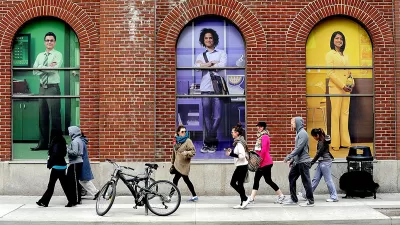Though the role for planners in making it easier to walk was clear even before the U.S. Surgeon General urged communities to design and plan for walking, more information is needed to understand why and where people choose to travel on foot.

"Sitting is the new smoking," as the saying goes. Standing and walking are increasingly recognized as important to one's health. There has been a great deal of attention in the transportation community to the walk mode over the past few years. The motivations have gone beyond sustainable transportation to explicitly embrace the importance of walking as an element of keeping healthy. Recently the Surgeon General released a report, Step It Up! The Surgeon General’s Call to Action to Promote Walking and Walkable Communities, reiterating the importance of walking to the population’s health. The challenge to planners was very specific in the report's call to action:
This means that the people who design our cities and neighborhoods should include well-maintained sidewalks, pedestrian-friendly streets, access to public transit, adequate lighting, and desirable destinations that are close to home.
The 70+ page report serves as a powerful affirmation of the breadth of stakeholders in support of walking.
Plus, analysts are increasingly articulating the benefits of walking beyond the immediate metrics of trips and miles walked by pointing out that walking compliments other sustainable modes like bike and transit. Walking environments offer benefits beyond those one might discern from a first look at the metrics (like person miles of travel by walking) because walkable environments may more profoundly alter behaviors beyond mode choice to include residential location decisions, trip destination decisions, and vehicle ownership decisions.
Of course transportation and urban planners have been sensitive to walking and accommodating pedestrians for years. There have been strong advocacy and technical capabilities within the planning communities for some time, and there is a plethora of guidance on how to accommodate pedestrians in infrastructure design. Researchers have used any number of analyses to attempt to establish the relationship between walking and various transportation and quality of life metrics with the hope of building the foundation for increased rates of walking.
As planners are most typically concerned with infrastructure, there is a temptation to interpret the modest levels of walking as linked to a need for more walking infrastructure and accommodative urban design. It's not uncommon to encounter presumptions that decreased walking is attributable to suburban sprawl and the lack of street connectivity and sidewalks.
Unfortunately the information about walking levels and motivations has not achieved as high a quality as one would like. Historically, transportation planners focused on meeting infrastructure needs, which typically meant worrying about roadway demand. Surveys such as the early National Household Travel Survey asked about walking, but often respondents don't even consider walking as a trip and tended to underreport it—particularly for non-work purposes. The surveying was further compromised by respondents whose recreational walking didn't have a traditional, non-home destination (i.e., the trip starts and ends at home). More recently, surveys more explicitly capture walking behaviors, but method changes compromise interpretation of trend data. Some of our best data on walking comes from the census and American Community Survey, which only focuses on usual mode (used the majority of days in the prior week) for commuting to work.
Walking has declined over time in both absolute numbers of commuters walking to work and, even more significantly, in terms of the share of commuters walking. As shown in Figure 1, this trend appears to be arrested and recent data suggests a modest recovery in the absolute number of walk commuters.
Figure 1 Long-Term Trend in Walk Commute Mode Share

In Figure 2, ACS data also show that there is a strong relationship between income and walk commuting. This is probably attributable to two considerations. First, low income households are less likely to have vehicles available for commuting and more likely to be captive to walking. In addition, lower income households are likely to have shorter commutes that are more conducive to walking. Low income employment is less specialized, hence there is likely a lower necessity, ability, and economic justification to travel long distances for a more unique employment context that might be relevant for high skilled, high paid professionals.
ACS data also reveals additional information about walk commuting. Approximately 90 percent of walk trips are less than the mean commute time of approximately 25 minutes in 2012. That suggests a willingness to walk up to approximately 1.5 miles at the nominal walk speed of 3 mph. An estimated 13 percent of all commute trips are less than 1.5 miles, thus there are approximately 17 million commuters with workplace destinations within 1.5 miles of their homes. Given nearly 4 million usual walk commuters in the United States, walking has an approximate 20-25 percent share for trips less than 1.5 miles. The work trip walk mode share is estimated to be nearly 50 percent for trips under one half mile [pdf]. In the fun facts column, 150,000 persons walk to a workplace outside their county of residence.
Figure 2 Walk Commuter Mode Shares by Household Income Category

These data hint at some aspects of walking that need to be considered when speculating on how various investments or actions might influence walking behaviors. Beyond recreation, walking may well be driven by the need to walk versus the desire to walk. While the quality of supporting infrastructure may be of consideration, planners need to be careful to understand the relative significance of this factor in the context of other considerations, such as personal safety, weather exposure, tolerance of slower travel speeds, availability of travel alternatives, and, perhaps, other factors. It would be interesting to see how different walking behaviors are today from the behaviors that existed 50 years ago in urban environments that are nearly identical to those that existed 50 years ago. Our core urban areas in some major cities like Washington. D.C., Chicago, Philadelphia, Boston, Savannah, and dozens of others are not markedly different today in terms of roadway and sidewalk infrastructure than was the case decades ago when walking was common. It would be insightful to fully understand the changes in walking behaviors and the contributing factors.
The specialization of activities, including employment, may be contributing to a lessened accessibility to desired destinations in spite of constant land use density. Similarly the increase in the scale of various enterprises (for example, elementary schools are at least three times larger on average than was the case several decades ago) may be impacting the propensity to walk even in environments where infrastructure conditions are conducive.
Aspirations to enhance walking have noble motivations and a multitude of supporting stakeholders; however, expectations and investment priorities targeted to increasing walking should be governed by a rich understanding of the full spectrum of behaviors that influence the propensity to walk. Just as a health club membership or guest room or basement full of exercise equipment doesn’t ensure vigorous exercise absent the will to use them, better walking infrastructure is only a partially necessary and definitely not an assured way to increase walking. Even individuals who suffer heart attacks and stroke and are presumably highly motivated to alter lifestyles are resistant to doctor's advice—only 35 percent report a more active lifestyle after a health event.
There is clearly an interest in walkable environments, evidence of a market premium for some walkable communities, and what appears to be some self-selection by segments of the market who aspire to this lifestyle choice. The magnitude of the market, the relative importance of walking infrastructure in the mix of what makes these environments work, and the travel and health impacts and costs will merit further scrutiny as planners seek to productively deploy scarce resources. As is often the case, providing transportation infrastructure will require more nuanced thinking than "build it and they will come."
Then again, the National Household Travel Survey data says that about 10 percent of walking is for taking pets for walks. Perhaps the best way to increase walking is to give away puppies.

Planetizen Federal Action Tracker
A weekly monitor of how Trump’s orders and actions are impacting planners and planning in America.

Chicago’s Ghost Rails
Just beneath the surface of the modern city lie the remnants of its expansive early 20th-century streetcar system.

San Antonio and Austin are Fusing Into one Massive Megaregion
The region spanning the two central Texas cities is growing fast, posing challenges for local infrastructure and water supplies.

Since Zion's Shuttles Went Electric “The Smog is Gone”
Visitors to Zion National Park can enjoy the canyon via the nation’s first fully electric park shuttle system.

Trump Distributing DOT Safety Funds at 1/10 Rate of Biden
Funds for Safe Streets and other transportation safety and equity programs are being held up by administrative reviews and conflicts with the Trump administration’s priorities.

German Cities Subsidize Taxis for Women Amid Wave of Violence
Free or low-cost taxi rides can help women navigate cities more safely, but critics say the programs don't address the root causes of violence against women.
Urban Design for Planners 1: Software Tools
This six-course series explores essential urban design concepts using open source software and equips planners with the tools they need to participate fully in the urban design process.
Planning for Universal Design
Learn the tools for implementing Universal Design in planning regulations.
planning NEXT
Appalachian Highlands Housing Partners
Mpact (founded as Rail~Volution)
City of Camden Redevelopment Agency
City of Astoria
City of Portland
City of Laramie






























